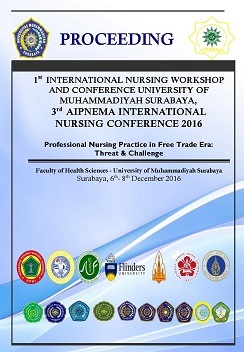Exclusive Breastfeeding Practice Of Mothers In Breastfeeding Phase In Surabaya
Abstrak
Introduction: One of the biggest challenges in improving the health of babies in Indonesia was non optimal breastfeeding. The level of breastfeeding to infants who were not optimal thus a threat to the health of young generation. The Target of exclusive breastfeeding nationwide was 80%. Meanwhile, the Provincial Health Office report in 2013 that coverage of exclusive breastfeeding in Indonesia was 54.3%. The purpose of this study was to explore the practice of exclusive breastfeeding in mother. The type of research was a qualitative research approach explorative descriptive. The informant were 50 mothers with children aged 7-23 months who represent the five regions of Surabaya. Health centers where research were Dupak, Benowo, Mulyorejo, Gayungan, and Ketabang. The research process through three stages: getting in, getting a long, and logging the data. The process of data analysis using data interpretation nine steps according Colluizi. Results: there are five big themes of the data analysis, namely: perception, support, barriers, media, and hope in the process of breastfeeding. The practice of exclusive breastfeeding is often challenging, especially in working mother. Limitations of breastfeeding facilities, low maternal knowledge, low support from husbands, recommendation from mother or mother in law to give formula can support the failure of exclusive breastfeeding. In addition, there was a community pride when giving the expensive formula to children. The effect of advertising infant formula was also shifts the paradigm of breastfeeding as the best food. Conclusion: The efforts to increase coverage of exclusive breastfeeding can do with the provision of education to the husband and family. In addition, the mentoring program by health professionals need to be improved. Breastfeeding promotion in electronic media also need special attention to building paradigms and community pride to give breastmilk as the best food for babies. Keywords: exclusive breastfeeding, mothers in the breastfeeding phase, SurabayaReferensi
Creswell, J.W. (2012). Research Design; Qualitative, Quantitative, and Mixed Methods Approach, Sage, Los Angeles.
Collins T. 2003. Models of health: pervasive, persuasive and politically charged. In: Sidell M, Jones L, Katz J, Paberdy A, Douglas J, editors. Debate and Dilemmas in Promoting. 2nd ed. New York: Palgrave MacMillan. p. 62-8.
Fleming ML, Parker E. 2007. Health promotion: principles and practice in the Australian context. 3rd ed. Sydney: Ligare Book Printer.
House JS, Williams DR.2002.Understanding and reducing socioeconomic and racial/ethnic disparities in health. In: Syme SL, Reeder LG, editors. Promoting Health Intervention Strategies From Social and Behavioral Research. 3rd ed. Washington DC: National Academy Press. p.81-116.
Ife, Tesoriero F. 2010. Community development: community-based alternatives in an age of globalisation. Pearson Education Australia. Unit 4. Level 2. 14 Aquatic Drive Frenchs Fores NSW.
Khoriddin (1992). Pembangunan Masyarakat. Yogyakarta: Liberty.
Mardikanto T. 2010. Model-model pemberdayaan masyarakat. 1st ed. Surakarta: Kerjasama Fakultas Pertanian UNS dengan UPT Penerbitan dan Percetakan UNS (UNS Press).
Mardikanto T. 2010. Model-model pemberdayaan masyarakat. 1st ed. Surakarta: Kerjasama Fakultas Pertanian UNS dengan UPT Penerbitan dan Percetakan UNS (UNS Press).
Moelong, J. Lexy. 2001. Metodologi Penelitian Kualitatif. Bandung: Remaja Rosdakarya.
Nurmiati dan Besral. (2008). Pengaruh Durasi Pemberian ASI terhadap Ketahanan Hidup Bayi di Indonesia. Makara Kesehatan. Vol.12 (2), 47-52.
Lewis GH, Sheringham J, Kalim K, Crayford TJ. Mastering public health a postgraduate guide to examinations and revalidation. Australia: Royal Society of Medicine Press Ltd. Elsevier; 2008.
Pemerintah Republik Indonesia, United Nations International Children’s Emergency Fund.1999. Panduan umum pemberdayaan masyarakat di bidang kesehatan ibu dan anak. Jakarta.
Rehn NS, Ovretveit J, Laamanen R, Suominen S, Sundel J, Brommels M. 2006. Determinants of health promotion action: comparative analysis of local voluntary associations in four municipalities in Finland. Health Promotion International.; 21 (4): 274-83.
Roesli, Utami. 2005. Mengenal ASI Eksklusif – Seri 1. Jakarta: Trubus Agriwidya.
Saleha, 2009. Asuhan Kebidanan Pada Masa Nifas. Jakarta: Salemba Medika (hlm: 11-18)Undang-Undang Republik Indonesia Nomor 36 Tahun 2009 Tentang Kesehatan, Pasal 128 Ayat 1.
Speziale, H.J.S., & Carpenter, D.R. (2003). Qualitative Research in Nursing third edition. Philadelphia : Lippincott Williams & Wilkins.
Undang-Undang Republik Indonesia Nomor 36 Tahun 2009 Tentang Kesehatan, Pasal 128 Ayat 1






